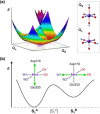Orientational Jahn-Teller Isomerism in the Dark-Stable State of Nature's Water Oxidase
- PMID: 33830630
- PMCID: PMC8252073
- DOI: 10.1002/anie.202103425
Orientational Jahn-Teller Isomerism in the Dark-Stable State of Nature's Water Oxidase
Abstract
The tetramanganese-calcium cluster of the oxygen-evolving complex of photosystem II adopts electronically and magnetically distinct but interconvertible valence isomeric forms in its first light-driven oxidized catalytic state, S2 . This bistability is implicated in gating the final catalytic states preceding O-O bond formation, but it is unknown how the biological system enables its emergence and controls its effect. Here we show that the Mn4 CaO5 cluster in the resting (dark-stable) S1 state adopts orientational Jahn-Teller isomeric forms arising from a directional change in electronic configuration of the "dangler" MnIII ion. The isomers are consistent with available structural data and explain previously unresolved electron paramagnetic resonance spectroscopic observations on the S1 state. This unique isomerism in the resting state is shown to be the electronic origin of valence isomerism in the S2 state, establishing a functional role of orientational Jahn-Teller isomerism unprecedented in biological or artificial catalysis.
Keywords: EPR spectroscopy; bioinorganic chemistry; computational chemistry; electronic structure; photosynthesis.
© 2021 The Authors. Angewandte Chemie International Edition published by Wiley-VCH GmbH.
Conflict of interest statement
The authors declare no conflict of interest.
Figures





Similar articles
-
What Can We Learn from a Biomimetic Model of Nature's Oxygen-Evolving Complex?Inorg Chem. 2017 Apr 3;56(7):3875-3888. doi: 10.1021/acs.inorgchem.6b02777. Epub 2017 Mar 14. Inorg Chem. 2017. PMID: 28291351
-
S1-state Mn4Ca complex of Photosystem II exists in equilibrium between the two most-stable isomeric substates: XRD and EXAFS evidence.J Photochem Photobiol B. 2011 Jul-Aug;104(1-2):100-10. doi: 10.1016/j.jphotobiol.2011.03.002. Epub 2011 Mar 13. J Photochem Photobiol B. 2011. PMID: 21592813 Review.
-
Spin, Valence, and Structural Isomerism in the S3 State of the Oxygen-Evolving Complex of Photosystem II as a Manifestation of Multimetallic Cooperativity.J Chem Theory Comput. 2019 Apr 9;15(4):2375-2391. doi: 10.1021/acs.jctc.8b01055. Epub 2019 Mar 11. J Chem Theory Comput. 2019. PMID: 30855953
-
Reconciling Structural and Spectroscopic Fingerprints of the Oxygen-Evolving Complex of Photosystem II: A Computational Study of the S2 State.J Phys Chem B. 2018 Dec 20;122(50):11868-11882. doi: 10.1021/acs.jpcb.8b08147. Epub 2018 Nov 28. J Phys Chem B. 2018. PMID: 30444623
-
Biological water oxidation.Acc Chem Res. 2013 Jul 16;46(7):1588-96. doi: 10.1021/ar3003249. Epub 2013 Mar 18. Acc Chem Res. 2013. PMID: 23506074 Review.
Cited by
-
An analysis of the structural changes of the oxygen evolving complex of Photosystem II in the S1 and S3 states revealed by serial femtosecond crystallography.Biochim Biophys Acta Bioenerg. 2025 Apr 1;1866(2):149531. doi: 10.1016/j.bbabio.2024.149531. Epub 2024 Dec 16. Biochim Biophys Acta Bioenerg. 2025. PMID: 39694218 Review.
-
Dissecting Electronic-Structural Transitions in the Nitrogenase MoFe Protein P-Cluster during Reduction.J Am Chem Soc. 2022 Apr 6;144(13):5708-5712. doi: 10.1021/jacs.1c13311. Epub 2022 Mar 22. J Am Chem Soc. 2022. PMID: 35315658 Free PMC article.
-
Mutation-induced shift of the photosystem II active site reveals insight into conserved water channels.J Biol Chem. 2024 Jul;300(7):107475. doi: 10.1016/j.jbc.2024.107475. Epub 2024 Jun 13. J Biol Chem. 2024. PMID: 38879008 Free PMC article.
-
Closing Kok's cycle of nature's water oxidation catalysis.Nat Commun. 2024 Jul 16;15(1):5982. doi: 10.1038/s41467-024-50210-6. Nat Commun. 2024. PMID: 39013902 Free PMC article.
-
Comprehensive Evaluation of Models for Ammonia Binding to the Oxygen Evolving Complex of Photosystem II.J Phys Chem B. 2024 Feb 15;128(6):1333-1349. doi: 10.1021/acs.jpcb.3c06304. Epub 2024 Feb 1. J Phys Chem B. 2024. PMID: 38299511 Free PMC article.
References
Publication types
MeSH terms
Substances
LinkOut - more resources
Full Text Sources
Other Literature Sources

